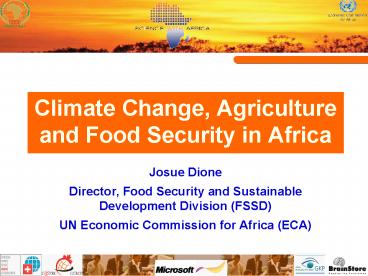Climate Change, Agriculture and Food Security in Africa - PowerPoint PPT Presentation
1 / 15
Title:
Climate Change, Agriculture and Food Security in Africa
Description:
Director, Food Security and Sustainable Development Division (FSSD) ... and increased production cost of livestock (reduced feed and fodder availability) ... – PowerPoint PPT presentation
Number of Views:24
Avg rating:3.0/5.0
Title: Climate Change, Agriculture and Food Security in Africa
1
Climate Change, Agriculture and Food Security in
Africa
- Josue Dione
- Director, Food Security and Sustainable
Development Division (FSSD) - UN Economic Commission for Africa (ECA)
2
Outline
- Agriculture, food security and poverty reduction
- Under-investment in, under-capitalization and
poor performance of agriculture - Implications for agricultural RD
- Compounding impacts of climate change
- Additional challenges for agricultural RD
3
Agriculture, Food Security and Poverty Reduction
- 70 of the poor in Africa live in rural areas
- Livelihoods of 90 of rural people depend
directly or indirectly on agriculture - 60 of the total labor force is employed in
agriculture - Large proportion of urban employment is linked to
agriculture (esp. women in informal sector) - Urban poor spend 60 of their budget on food
- Strong link between agricultural growth and
overall economic growth (1.5-2.7 multipliers)
4
Under-investment in Agriculture
- Decrease in the proportion of public spending on
agriculture from 6.4 in 1980 to 4.5 in 2002
AU Maputo 2003 Summit commitment to increase this
at 10 minimum by 2008 - Decline in public spending on agricultural
research from 0.93 of agricultural GDP in 1981
to 0.69 in the 1990s (compared to 2.4 in
industrial countries) - Fall of official development assistance to
agriculture by 65 between the late 1980s and
late 1990s
5
Under-capitalization of Agriculture
- Only 6 of the arable is irrigated, against 40
in Asia - 20 kg of fertilizer per hectare of arable land in
Africa (8 kg/ha in SSA), i.e. 22 (and 9) of
world average - Tractors per 1000 ha of arable land 3 times less
than in Asia and 8 times less than in Latin
America - Road density is 2.5 times less than in Latin
America and 6 times less than in Asia - Poor rural access to energy and
telecommunications - Institutions of agricultural education, research
and extension are poorly staffed, under-equipped
and under-funded
6
Poor Performance of Agriculture
- Land productivity at 42 of that in Asia and 50
of that in Latin America - Labor productivity at 60 of that in Asia and
Latin America - Sharp fall of share of global agricultural
exports from 15 in the mid-1960s to 5 in 2000 - Food imports increasing at 3.2 per year, from
US 13 bn in 1990-92 to US 20 bn in 2002-04 - Close to US 2bn of food aid per year
- Yet, over 25 of Africas population is
undernourished
7
Implications for Agricultural RD
- Challenge of addressing, for structural and
sustainable development of African agriculture,
issues of/gaps in - Technologies
- Infrastructure
- Institutions
- Policies
- Not only at farm level, but throughout value
chains of strategic food and agricultural
commodities (maximum efficiency minimum
transactions costs)
8
Compounding Impacts of Climate Change
9
Compounding Impacts of Climate Change
- Projected impacts of CC on agriculture from IPCC
Assessment, Stern Review and other major studies - Reduced rainfall up to 10 decrease in Southern
Africa and parts of the Horn of Africa by 2050 - Reduced water resources from major glaciers
(Kilimanjaro, Kenya, Rwenzori), major lakes
(Victoria, Chad) and rivers (e.g. Nile, Niger,
Zambezi) - Reduced area suitable to agriculture increase in
arid and semi-arid areas by 60-90 million hectares
10
Compounding Impacts of Climate Change
- Reduced soil moisture storage capacity, quality
and fertility with higher temperatures - Reduced length of growing seasons by more than
20 in the Sahel by 2020 with an additional 0.4C - Increased proliferation of pests and incidence of
pest attacks - Constrained availability of human resources
(labour) due to expanded range and prevalence of
vector-borne diseases (in addition to HIV/AIDS)
11
Compounding Impacts of Climate Change
- Reduced crop yields from rain-fed agriculture by
up to 50 in many countries and income by 11
(irrigated agriculture) to 31 (dryland
agriculture) Cline 2007 - Reduced productivity and increased production
cost of livestock (reduced feed and fodder
availability) - Reduced fisheries resources from lakes due to
rising temperatures - Increased food insecurity and poverty for
hundreds of people more, under business as usual
12
Additional Challenges for Agricultural RD
- Developing value chains of selected strategic
food and agricultural commodities within a
framework of regional integration - Adopted by AU/NEPAD Food Security Summit of
December 2006 - Rice, maize, legumes, cotton, oil palm, beef,
dairy, poultry and fisheries products at
continental level - Cassava, sorghum and millet at regional level
13
Additional Challenges for Agricultural RD
- Linking the NEPAD/CAADP pillars around such
strategic commodities within a framework of
regional integration Regional Strategic
Commodity Belts - Sustainable land and water management pillar
- Infrastructure, trade capacities and market
access pillar - Food supply chain and emergency response pillar
- Research, technology dissemination and adoption
Regional RD Centers of Excellence
14
Additional Challenges for Agricultural RD
- Some major RD issues to ponder
- Comparative advantage Re. The development of
Regional strategic commodity belts and value
chains -- How would climate change impact
agro-ecological zones, comparative potential and
advantage for different commodities,
specialization/diversification? - Growth and adaptation strategies What are the
implications of CC for research on crop and
animal breeding, water resources management, soil
fertility management, food crisis prevention
strategies, etc.?
15
Additional Challenges for Agricultural RD
- Some major RD issues to ponder
- Land for forests vs. agriculture What are the
tradeoffs between expanding land under
agriculture and keeping forests for CC
mitigation? - Cropping for food, feed, fiber or fuel What are
the recommendable options, their costs/benefits
and RD implications? - THANK YOU































